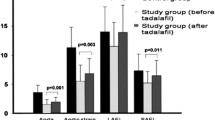Abstract
The plasma concentration of asymmetrical dimethylarginine (ADMA), an inhibitor of nitric oxide synthase, has been linked to endothelial dysfunction. We investigated the relation between plasma ADMA concentration and severity of erectile dysfunction (ED) and coronary artery disease (CAD). We measured plasma levels of ADMA in 92 male patients. Patients were divided into three groups: group 1 (n = 41), patients with ED and without CAD; group 2 (n = 29), patients with stable CAD; group 3 (n = 22), control group (patients without CAD or ED). Erectile function was evaluated by the erectile function domain of the international index of erectile function (IIEF-EFD) a validated 15-item self-administered questionnaire. Erectile function is specifically addressed by six questions that form the so-called erectile function domain of the questionnaire. Each question is scored 0–5. ED is defined as any value <26. Patients with CAD who have stable angina pectoris were selected after coronary angiography. ADMA was analyzed by ELISA method. Group 1 had significantly higher concentrations of plasma ADMA than groups 2 and 3 (respectively, 0.75 ± 0.40 vs. 0.50 ± 0.30, P = 0.013; 0.75 ± 0.40 vs. 0.50 ± 0.25, P = 0.021). There was negative correlation between ADMA and IIEF-EFD score in all groups (n = 92) (r = −0.322, P = 0.002). In a multiple logistic regression analysis adjusting for age, hyperlipidemia, ADMA remained independent predictor for severe ED. Odds ratio for plasma ADMA was 14.151 (1.101–181.940; P = 0.042). First of all, this study provides that ADMA concentrations are significantly higher in patients who have ED when compared to patients with CAD and controls. Second, there was a negative correlation between ADMA and severity of ED. Elevating levels of circulating ADMA is an independent risk factor for severe of ED, and ADMA may be a link between CAD and ED.


Similar content being viewed by others
References
Masuda H (2008) Significance of nitric oxide and its modulation mechanisms by endogenous nitric oxide synthase inhibitors and arginase in the micturition disorders and erectile dysfunction. Int J Urol 15(2):128–134
Cooke JP (2003) NO and angiogenesis. Atheroscler Suppl 4(4):53–60
Wierzbicki AS, Solomon H, Lumb PJ et al (2006) Asymmetric dimethyl arginine levels correlate with cardiovascular risk factors in patients with erectile dysfunction. Atherosclerosis 185(2):421–425
Montorsi P, Ravagnani PM, Galli S et al (2006) Association between erectile dysfunction and coronary artery disease: matching the right target with the right test in the right patient. Eur Urol 50(4):721–731
Cappelleri JC, Rosen RC, Smith MD, Mishra A, Osterloh IH (1999) Diagnostic evaluation of the erectile function domain of the international index of erectile function. Urology 54(2):346–351
Valkonen VP, Päivä H, Salonen JT et al (2001) Risk of acute coronary events and serum concentration of asymmetrical dimethylarginine. Lancet 358:2127–2128
Billups KL, Kaiser DR, Kelly AS et al (2003) Relation of C-reactive protein and other cardiovascular risk factors to penile vascular disease in men with erectile dysfunction. Int J Impot Res 15(4):231–236
Maas R, Schwedhelm E, Albsmeier J, Böger RH (2002) The pathophysiology of erectile dysfunction related to endothelial dysfunction and mediators of vascular function. Vasc Med 7(3):213–225
Böger RH (2003) Association of asymmetric dimethylarginine and endothelial dysfunction. Clin Chem Lab Med 41(11):1467–1472
Chiurlia E, D’Amico R, Ratti C, Granata AR, Romagnoli R, Modena MG (2005) Subclinical coronary artery atherosclerosis in patients with erectile dysfunction. J Am Coll Cardiol 46(8):1503–1506
Jonasson TF, Hedner T, Hultberg B, Ohlin H (2003) Hyperhomocysteinaemia is not associated with increased levels of asymmetric dimethylarginine in patients with ischaemic heart disease. Eur J Clin Invest 33(7):543–549
Wang J, Sim AS, Wang XL, Salonikas C, Naidoo D, Wilcken DE (2006) Relations between plasma asymmetric dimethylarginine (ADMA) and risk factors for coronary disease. Atherosclerosis 184(2):383–388
Deng S, Deng PY, Jiang JL et al (2004) Aspirin protected against endothelial damage induced by LDL: role of endogenous NO synthase inhibitors in rats. Acta Pharmacol Sin 25(12):1633–1639
Bode-Böger SM, Martens-Lobenhoffer J, Täger M, Schröder H, Scalera F (2005) Aspirin reduces endothelial cell senescence. Biochem Biophys Res Commun 334(4):1226–1232
Elesber AA, Solomon H, Lennon RJ et al (2006) Coronary endothelial dysfunction is associated with erectile dysfunction and elevated asymmetric dimethylarginine in patients with early atherosclerosis. Eur Heart J 27(7):824–831
Böger RH, Ron ES (2005) l-Arginine improves vascular function by overcoming deleterious effects of ADMA, a novel cardiovascular risk factor. Altern Med Rev 10:14–23
Chen J, Wollman Y, Chernichovsky T, Iaina A, Sofer M, Matzkin H (1999) Effect of oral administration of high-dose nitric oxide donor l-arginine in men with organic erectile dysfunction: results of a double-blind, randomized, placebo-controlled study. BJU Int 83(3):269–273
Author information
Authors and Affiliations
Corresponding author
Rights and permissions
About this article
Cite this article
Aktoz, T., Aktoz, M., Tatlı, E. et al. Assessment of the relationship between asymmetric dimethylarginine and severity of erectile dysfunction and coronary artery disease. Int Urol Nephrol 42, 873–879 (2010). https://doi.org/10.1007/s11255-009-9696-9
Received:
Accepted:
Published:
Issue Date:
DOI: https://doi.org/10.1007/s11255-009-9696-9




